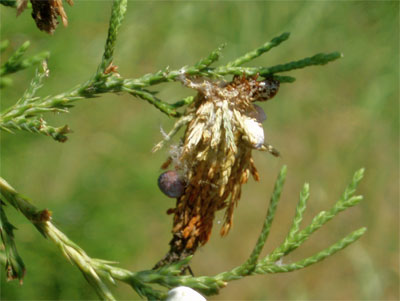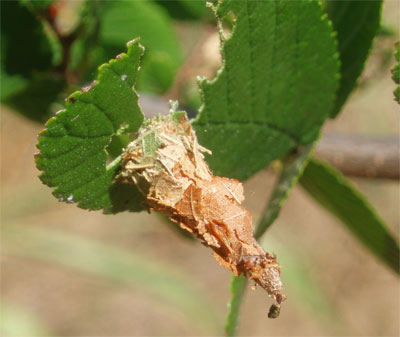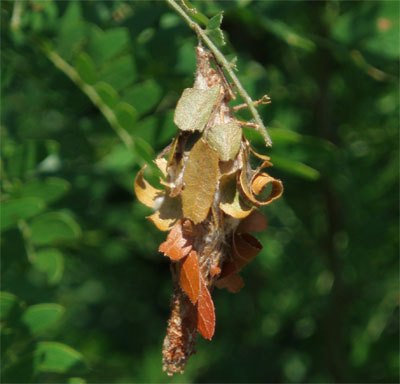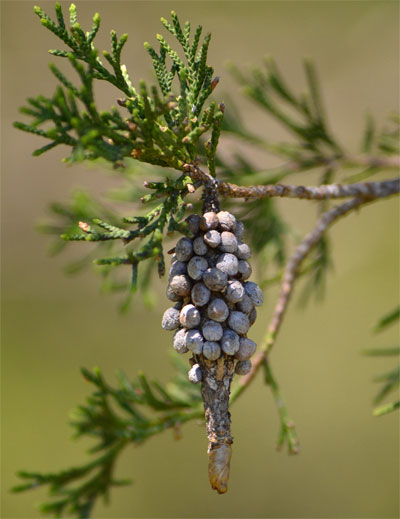Texas Tree Tips: June 2014

With its house secured in place with silken threads, this bagworm grasps onto eastern red cedar foliage and gorges on tender growth. Photos by Bill Seaman.
By Bill Seaman
Tree Insect Pests — Send Those Bagworms Packing
Bagworms may be best known by the company they keep. Because the pests are so frequently found on eastern red cedar and arborvitae, both conifers have the colloquial names of “bagworm trees.” That is unfortunate for two trees that have much more to offer Texas landscapes than the unusual insect pests associated with them. While bagworms do have a reputation for devouring “cedars” when present in large enough numbers, they are opportunistic and will chow down on almost any plant where the wind will take them — literally.
The bagworms’ life cycle begins in May and early June, when eggs hatch into caterpillars that are a mere 1/25 of an inch in length. So small and lightweight, they each spin a silken thread that allows them to drop to green foliage below their familial birthplace; or on a breezy day, they use the thread like a broken kite string and ride the wind to a new host plant. Since crawling is an inefficient method of transportation for a caterpillar that forever lives out of a travel trailer, riding the wind while young proves to be the better technique for moving through the garden or landscape.

Less than ½-inch long and still in its “dunce cap” juvenile posture, this young bagworm feeds on cedar elm leaves and decorates its house with leftovers.
Once the youngster stakes a claim, it begins feeding and constructing its namesake structure. On conifers such as juniper, cypress, and arborvitae, the juveniles migrate to the tender new growth at the tips of twigs and stems. On broadleaf trees and shrubs like bur oaks, honey locusts, sycamores, and roses, they venture out on any lush foliage. At this stage, the juveniles carry their houses around like dunce caps, keeping the cap upright, and keeping their heads and mouthparts close to the food. For the first few weeks, they may be able to eat only the uppermost cells on the leaf, leaving a skeletonized leaf in their tracks.
That all changes once they become 1/4 to 1/2-inch in length, when they take a bagworm’s traditional posture and they begin gorging and leaving behind only the toughest leaf veins. When they reach this stage on conifers, the tree’s outermost green needles or scales begin to disappear, exposing a leafless interior. Left unchecked, bagworms can defoliate and kill Italian cypress, arborvitae, eastern red cedar, and similar conifers. Deciduous trees including bald cypresses, bur oaks, sycamores, and elms are much more resilient and can generate a new flush of growth once the bagworm feeding frenzy stops. However, defoliation has a negative effect on any tree’s general health.

At almost 2 inches long and adorned with honey locust leaflets, this bagworm has secured its home in preparation to pupate.
By August, the bagworm’s home reaches 1-1/2 to 2 inches in length. As the house has grown, the bagworm has decorated the exterior of the silk bag with evidence of the host plant. On close observation, bags removed from eastern red cedar have been shingled with leaf scales and short needles, along with an occasional berry placed toward the top. A bag plucked from a honey locust has been decorated with leaflet pieces carefully arranged like shingles on the gable of a Victorian-style house. Each bag features the siding materials provided by the host.

An adult male bagworm moth has left behind its house and pupae covering (protruding from the base of the bag) to seek out a mature female.
By September the feeding stops. The damage to trees is done. The bagworms seal their homes and spend a few weeks in a pupae stage. For the males, the transformation changes them into 1-inch long black moths with clear wings. For the females, the transformation converts them into egg-producing grubs with no wings, legs, antennae, or functional mouthparts. Once fertilized by the male, the adult female bagworm lays from 400 to 1,000 eggs inside her structure — and then dies. The eggs remain in the bag until the next year’s caterpillars hatch the following May, completing the cycle.
Managing bagworms can be something of a challenge. Plucking the “ornaments” from the tree is the first line of defense. However, this approach is practical only when the host tree is small and the bagworms can be reached. If this method is doable, always dispose of the bags. If the bags are simply dropped to the ground, the feeding caterpillars will drag themselves and their homes back up into the tree you removed them from, or find other plants to feed upon. If bags are plucked between September and May, again dispose of them, since those bags once occupied by female bagworms can contain hundreds of eggs awaiting a spring hatch.
Bagworms can be successfully managed with insecticides. A spray application of Bt (Bacillus thuringiensis) on the foliage of the host tree is the old standard, particularly for young caterpillars. Reapply Bt should rain wash the material off the foliage before the bagworms have had time to ingest it. There are numerous other insecticides labeled for managing bagworms. Your local independent nurseryman can help you determine which product best meets your needs.
If you have had bagworms in your Texas garden or landscape, now is the time to make a close inspection of trees and shrubs that have hosted the pests in previous years. If you are one of the fortunate gardeners who have managed to evade the bizarre caterpillars, count your lucky stars — and do a quick inspection just the same. It’s time to send those bagworms packing.

